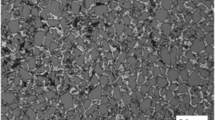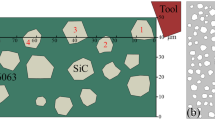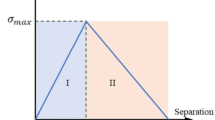Abstract
SiCp/Al composites (Silicon Carbide Particles embedded in an Aluminum matrix) are widely used in aerospace, automotive and other fields due to their excellent properties such as high dimensional stability and high specific strength. But, the large hardness of SiCp particles makes the processing of SiCp/Al difficult .The position of SiC particles relative to the cutting path determines the interaction between the tool and the particles, which affects the cutting process of SiCp/Al. However, there is a lack of study on the position of SiC particles relative to the cutting path. We study the processing mechanism of SiCp / Al under multistep cutting and propose a model of the relative position of the cutting path and the SiCp particle. To reduce particle damage during the cutting process, a quantitative relationship between cutting depth and the diameter of SiC particles is established for the first time in this paper. Finite element models considering particle shape, distribution, and cohesive element are established based on the above model. The particle removal mechanisms, cutting force characteristics, and surface quality are compared in detail for multi-step and single-step cutting. The simulation model is validated through experiment. The results show that the optimized multi-step cutting parameters can change the removal mode of particles from overall debonding to local fracture, effectively reduce the machining defects, and finally improve the surface quality of the workpiece. The Ra and SSD depths are reduced by 41.1% and 27.9%, respectively, when compared to single-step cutting.












Similar content being viewed by others
References
Gupta M, Wong WLE (2015) Magnesium-based nanocomposites: lightweight materials of the future. Mater Charact 105:30–46. https://doi.org/10.1016/j.matchar.2015.04.015
Kim CS, Cho K, Manjili MH, Nezafati M (2017) Mechanical performance of particulate-reinforced Al metal-matrix composites (MMCs) and Al metal-matrix nano-composites (MMNCs). J Mater Sci 52:13319–13349. https://doi.org/10.1007/s10853-017-1378-x
El-Gallab M, Sklad M (1998) Machining of Al/SiC particulate metal matrix composites: part II: workpiece surface integrity. J Mater Process Technol 83:277–285. https://doi.org/10.1016/S0924-0136(98)00072-7
Kannan S, Kishawy HA (2006) Surface characteristics of machined aluminium metal matrix composites. Int J Mach Tools Manuf 46:2017–2025. https://doi.org/10.1016/j.ijmachtools.2006.01.003
Pramanik A, Zhang LC, Arsecularatne JA (2007) An FEM investigation into the behavior of metal matrix composites: tool–particle interaction during orthogonal cutting. Int J Mach Tools Manuf 47:1497–1506. https://doi.org/10.1016/j.ijmachtools.2006.12.004
Nithiya Sandhiya YJ, Thamizharasan MM, Ajay Subramanyam BV, Vijay Sekar KS, Suresh Kumar S (2018) Finite element analysis of tool particle interaction, particle volume fraction, size, shape and distribution in machining of A356/SiCp. Mater Today: Proc 5:16800–16806. https://doi.org/10.1016/j.matpr.2018.06.006
Zhang ZW, Men XH, Pan YZ, Wang ZD, Shi QH, Fu XL (2021) Research on simulation of SiCp/Al finite element cutting based on cohesive model. Mater Today Commun 32:103848. https://doi.org/10.1016/J.MTCOMM.2022.103848
Han X, Xu DD, Axinte D, Liao ZR, Li HN (2021) On understanding the specific cutting mechanisms governing the workpiece surface integrity in metal matrix composites machining. J Mater Process Technol 288:116875. https://doi.org/10.1016/j.jmatprotec.2020.116875
Sun W, Duan CZ, Yin WD (2021) Chip formation mechanism in machining of Al/SiCp composites based on analysis of particle damage. J Manuf Process 64:861–877. https://doi.org/10.1016/j.jmapro.2021.02.032
Teng XY, Chen WQ, Huo DH, Shyha I, Lin C (2018) Comparison of cutting mechanism when machining micro and nano-particles reinforced SiC/Al metal matrix composites. Compos Struct 203:636–647. https://doi.org/10.1016/j.compstruct.2018.07.076
Lu SJ, Li ZQ, Zhang JJ, Zhang CY, Li G, Zhang HJ, Sun T (2022) Coupled effect of tool geometry and tool-particle position on diamond cutting of SiCp/Al. J Mater Process Technol 303:117510. https://doi.org/10.1016/j.jmatprotec.2022.117510
Du JG, Zhang HZ, He WB, Ma J, Ming WY, Cao Y (2019) Simulation and experimental study on surface formation mechanism in machining of SiCp/Al composites. Appl Compos Mater 26:29–40. https://doi.org/10.1007/s10443-018-9681-5
Yu WW, Chen J, Ming WW, An QL, Chen M (2021) Experimental and FEM study of cutting mechanism and damage behavior of ceramic particles in orthogonal cutting SiCp/Al composites. Ceram Int 47:7183–7194. https://doi.org/10.1016/J.CERAMINT.2020.11.072
Liu CR, Guo YB (2000) Finite element analysis of the effect of sequential cuts and tool–chip friction onresidual stresses in a machined layer. Int J Mech Sci 42:1069–1086. https://doi.org/10.1016/S0020-7403(99)00042-9
Sasahara H, Obikawa T, Shirakashi T (1996) FEM analysis of cutting sequence effect on mechanical characteristics in machined layer. J Mater Process Technol 62:448–453. https://doi.org/10.1016/S0924-0136(96)02451-X
Dehmani H, Salvatore F, Hamdi H (2013) Numerical Study of residual stress Induced by multi-steps Orthogonal cutting. Procedia CIRP 8:299–304. https://doi.org/10.1016/j.procir.2013.06.106
Li HN, Wang JP, Wu CQ, Zhao YJ, Xu J, Liu XL, Zhu WQ (2020) Damage behaviors of unidirectional CFRP in orthogonal cutting: a comparison between single- and multiple-pass strategies. Compos Part B 185:107774. https://doi.org/10.1016/j.compositesb.2020.107774
Lu SJ, Zhang JJ, Li ZQ, Zhang JG, Wang XH, Hartmaier A, Xu JF, Yan YD, Sun T (2021) Cutting path-dependent machinability of SiCp/Al composite under multi-step ultra-precision diamond cutting. Chin J Aeronaut 34:241–252. https://doi.org/10.1016/j.cja.2020.07.039
Lu SJ, Wang XH, Teng LC, Zhang JJ, Zhou ZG, Tong Z, Shao HY, Men HX (2022) Finite element analysis and experimental investigation of ultrasonic testing of internal defects in SiCp/Al composites. Ceram Int 48(5):5972–5982. https://doi.org/10.1016/j.ceramint.2021.11.133
Peng PC, Xiang DH, Lei XF, Shi ZL, Li B, Liu GF, Zhao B, Gao GF (2022) Study on the edge defects of high volume fraction 70% SiCp/Al composites in ultrasonic-assisted milling. Int J Adv Manuf Technol 122:485–498. https://doi.org/10.1007/S00170-021-08586-Y
Wang YF, Liao WH, Yang K, Chen WQ, Liu TT (2019) Investigation on cutting mechanism of SiCp/Al composites in precision turning. Int J Adv Manuf Technol 100:963–972. https://doi.org/10.1007/s00170-018-2650-1
Wang X, Li YQ, Xu JK, Yu HD, Liu QM, Liang W (2020) Comparison and research on simulation models of aluminum-based silicon carbide micro-cutting. Int J Adv Manuf Technol 1–17. https://doi.org/10.1007/s00170-020-05518-0
Wang XJ, Yang ZR, Xu FF, Wang LP (2019) Improving surface quality in microcutting of 10B/Al composite. Ind Lubr Tribol 71:672–676. https://doi.org/10.1108/ILT-03-2019-0079
Liu JW, Cheng K, Ding H, Chen SJ, Zhao L (2018) Simulation study of the influence of cutting speed and tool-particle interaction location on surface formation mechanism in micromachining SiCp/Al composites. Proc Inst Mech Eng Part C 232:2044–2056. https://doi.org/10.1177/0954406217713521
Acknowledgements
This work was supported by the Ningbo Major Science and Technology Project (2022Z013).
Author information
Authors and Affiliations
Contributions
Xu Zhang: Conceived and designed the study, collected and analyzed data, and drafted the manuscript.
Liangfei Hu: Contributed to the study design, perform finite element analysis, and contributed to the interpretation of results. Assisted in manuscript writing and revision.
Jia Ge: Participate in the analysis of results and critically review and revise manuscripts.
Xuechang Zhang: Provided critical feedback and revisions to the manuscript and secured funding for the research through a grant from the Ningbo Major Science and Technology Project (2022Z013).
All authors read and approved the final manuscript.
Corresponding authors
Ethics declarations
Conflict of interest
The authors declare that they have no known competing financial interests or personal relationships that could have appeared to influence the work reported in this paper.
Additional information
Publisher’s Note
Springer Nature remains neutral with regard to jurisdictional claims in published maps and institutional affiliations.
Rights and permissions
Springer Nature or its licensor (e.g. a society or other partner) holds exclusive rights to this article under a publishing agreement with the author(s) or other rightsholder(s); author self-archiving of the accepted manuscript version of this article is solely governed by the terms of such publishing agreement and applicable law.
About this article
Cite this article
Zhang, X., Hu, L., Ge, J. et al. Multi-step cutting depth optimization method based on the removal mechanism of SiCp/Al. Int J Adv Manuf Technol 131, 4499–4514 (2024). https://doi.org/10.1007/s00170-024-13273-9
Received:
Accepted:
Published:
Issue Date:
DOI: https://doi.org/10.1007/s00170-024-13273-9




